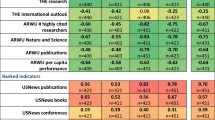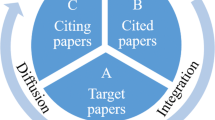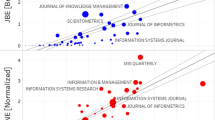Abstract
A university may be considered as having dimension-specific prestige in a scientific field (e.g., physics) when a particular bibliometric research performance indicator exceeds a threshold value. But a university has multidimensional prestige in a field of study only if it is influential with respect to a number of dimensions. The multidimensional prestige of influential fields at a given university takes into account that several prestige indicators should be used for a distinct analysis of the influence of a university in a particular field of study. After having identified the multidimensionally influential fields of study at a university their prestige scores can be aggregated to produce a summary measure of the multidimensional prestige of influential fields at this university, which satisfies numerous properties. Here we use this summary measure of multidimensional prestige to assess the comparative performance of Spanish Universities during the period 2006–2010.

Similar content being viewed by others
References
Aguillo, I. F., Bar-Ilan, J., Levene, M., & Priego, J. L. O. (2010). Comparing university rankings. Scientometrics, 85(1), 243–256.
Aksnes, D. (2003). Characteristics of highly cited papers. Research Evaluation, 12, 159–170.
Aksnes, D., & Sivertsen, G. (2004). The effect of highly cited papers on national citation indicators. Scientometrics, 59, 213–224.
Alkire, S., & Foster, J. (2008). Counting and multidimensional poverty measurement, Working Paper 7, Oxford: Oxford Poverty and Human Development Initiative (OPHI).
Billaut, J. C., Bouyssou, D., & Vincke, P. (2010) Should you believe in the Shanghai ranking?: An MCDM view. Scientometrics, 84(1), 237–263.
Bornmann, L., & Daniel, H. D. (2008). Selecting manuscripts for a high-impact journal through peer review: A citation analysis of communications that were accepted by Angewandte Chemie International Edition, or rejected but published elsewhere. Journal of the American Society for Information Science and Technology 59(11), 1841–1852.
Buela-Casal, G., Gutierrez-Martinez, O., Bermudez-Sanchez, M. P., & Vadillo-Muñoz, O. (2007). Comparative study of international academic rankings of universities. Scientometrics, 71(3), 349–365.
Dridi, C., Adamowicz, W. L., & Weersink, A. (2010). Ranking of research output of agricultural economics departments in Canada and selected US universities. Canadian Journal of Agricultural Economics, 58, 272–282. doi:10.1111/j.1744-7976.2010.01188.x.
Dusansky, R., & Vernon, C. J. (1998). Rankings of U.S. Economics Departments. Journal of Economic Perspectives, 12(1), 157–170.
Garcia, J. A., Rodriguez-Sanchez, R., & Fdez-Valdivia, J. (2011a). Overall prestige of journals with ranking score above a given threshold. Scientometrics, 89(1), 229–243.
Garcia, J. A., Rodriguez-Sanchez, R., & Fdez-Valdivia, J. (2011b). Ranking of the subject areas of scopus. Journal of the American Society for Information Science and Technology, 62(10), 2013–2023.
Garcia, J. A., Rodriguez-Sanchez, R., Fdez-Valdivia, J., & Martinez-Baena, J. (2012b). On first quartile journals which are not of highest impact. Scientometrics, 90(3), 925–943.
Garcia, J. A., Rodriguez-Sanchez, R., & Fdez-Valdivia, J. (2012a). A comparison of top economics departments in the US and EU on the basis of the multidimensional prestige of influential articles in 2010. Scientometrics. doi:10.1007/s11192-012-0708-7.
Herrera, M., Roberts, D. C., & Gulbahce, N. (2010). Mapping the evolution of scientific fields. PLoS ONE, 5:5, e10355.
Hirsch, J. E. (2005). An index to quantify an individual’s scientific research output. Proceedings of the National Academy of Sciences USA, 102(46), 16569–16572.
Lillquist, E., & Green, S. (2010). The discipline dependence of citation statistics. Scientometrics, 84:3, 749–762.
Liu, N. C., & Cheng, Y. (2005). Academic ranking of world universities: Methodologies and problems. Higher Education in Europe, 30(2), 127–136.
López-Illescas, C., Moya-Anegón, F., & Moed, H. F. (2011). A ranking of universities should account for differences in their disciplinary specialization. Scientometrics, 88(2), 563–574.
Peichl, A. Schaefer, T., & Scheicher, C. (2008). Measuring richness and poverty: A micro data application to Europe and Germany. IZA Discussion Paper, No. 3790.
Peichl, A., & Pestel, N. (2010). Multidimensional measurement of richness: Theory and an application to Germany. IZA Discussion Paper, No. 4825.
Porter, A. L., & Rafols, I. (2009). Is science becoming more interdisciplinary? Measuring and mapping six research fields over time. Scientometrics, 81:3, 719–745.
Rankings ISI of Spanish universities according to fields and scientific disciplines: Methodology, (2011). Retrieved Dec, 2011, from http://sci2s.ugr.es/rankinguniversidades/downloads/rankings_2011_methodologyEnglish.pdf.
Sen, A. (1976). Poverty: An ordinal approach to measurement. Econometrica, 44(2), 219–231.
Academic ranking of world universities (ARWU). (2011). Shanghai: Shanghai Jiao Tong University. Retrieved Dec, 2011, from http://www.arwu.org/index.js.
Shin, J. C., Toutkoushian, R. K., & Teichler, U. (Eds.). (2011). University rankings: Theoretical basis, methodology and impacts on global higher education (The Changing Academy—The Changing Academic Profession in International Comparative Perspective). Dordrecht: Springer, ISBN 9789400711167.
Takayama, N. (1979). Poverty, income inequality, and their measures: Professor Sen’s axiomatic approach reconsidered. Econometrica, 47(3), 747–759.
Torres-Salinas, D., Moreno-Torres, J. G., Delgado-López-Cózar, E., & Herrera, F. (2011a). A methodology for institution-field ranking based on a bidimensional analysis: The IFQ2A index. Scientometrics, 88, 771–786. doi:10.1007/s11192-011-0418-6.
Torres-Salinas, D., Moreno-Torres, J. G., Robinson-García, N., Delgado-López-Cózar, E., & Herrera, F. (2011b). Rankings ISI de las universidades españolas según campos y disciplinas científicas (2nd ed.). El Profesional de la Información, 20:6, 701–711.
Acknowledgments
This research was sponsored by the Spanish Board for Science and Technology (MICINN) under grant TIN2010-15157 cofinanced with European FEDER funds. Thanks are due to the reviewers for their constructive suggestions.
Author information
Authors and Affiliations
Corresponding author
Appendices
Appendix 1: Set of axioms
A first axiom states that a field of study at the given university which is not multidimensionally prestigious should not influence a summary measure of the overall prestige of multidimensionally influential fields.
Axiom 1
Given two configurations of dimension-specific scores X and \({\bf X}^{\prime}\) of the same size n × d where the scores of multidimensionally influential fields at the university are the same in both cases, the summary measure of the multidimensional prestige of influential fields measured on either configuration should give the same value.
A second axiom can be justified on the idea that small changes in the configuration of dimension-specific scores for multidimensionally influential fields of study shall not lead to discontinuously large changes in the summary measure of multidimensional prestige.
Axiom 2
The summary measure of the multidimensional prestige of influential fields at a given university should be a continuous function of dimension-specific scores for multidimensionally influential fields.
A third axiom states than an increment in some dimension-specific score (above the corresponding threshold z j ) for a multidimensionally influential field of study shall increase the summary measure.
Axiom 3
An index of multidimensional prestige of influential fields should increase whenever some dimension-specific score (above threshold z j corresponding to that dimension) rises for a multidimensionally influential field of study.
Next another axiom states a property of subgroup decomposability. That is, the index has to be additively decomposable, i.e., the index of overall prestige is a weighted sum over several subgroups of fields of study in which the complete set U can be partitioned.
Axiom 4
The overall prestige of multidimensionally influential fields can be decomposed into the weighted sum of subgroup-prestige indices.
And the following axiom requires that the summary measure of multidimensional prestige of influential fields shall increase after a progressive transfer (from a more influential field of study to a less prestigious one) of domain-specific scores above the corresponding threshold z j between two multidimensionally influential fields at the university.
Axiom 5
An overall prestige index should increase when a rank-preserving progressive transfer (above the corresponding domain-specific threshold) between two multidimensionally influential fields at a given university takes place.
Appendix 2: Proof of Theorem 1
Here we follow the proof given in (Garcia et al. 2012a).
Proof
Given a configuration X, let MPIF be a normalized weighted sum of the dimension-specific scores in X using weighting function f
where we have that f should be a continuous function for multidimensionally influential fields of study in order to satisfy Axiom 2, i.e., to verify that small changes in the configuration of dimension-specific scores (for multidimensionally influential fields at the university) shall not lead to discontinuously large changes in the summary measure MPIF.
But also it follows that weighting function f should be a strictly increasing function for multidimensionally influential fields of study at the university, since Axiom 3 states that an increment in some dimension-specific score (above the corresponding threshold z j ) for a multidimensionally influential field shall increase the summary measure of multidimensional prestige MPIF.
From Axiom 1, a field of study which is not multidimensionally prestigious should not influence the overall prestige MPIF, i.e., MPIF is independent of the dimension-specific scores for fields of study at the given university which are not multidimensionally influential. Hence to fulfill Axiom 1 we have that
for all i such that ϕ i (z; k) = 0; where ϕ i (z; k) equals to one if field s i is multidimensionally prestigious and zero otherwise, as given in Eq. (4).
Now, from Axiom 4, the summary measure MPIF can be decomposed into the weighted sum of subgroup prestige indices. Thus it follows that the measure MPIF has to be additively decomposable.
Finally, following Axiom 5, the summary measure of multidimensional prestige MPIF should increase after a progressive transfer (from a more influential field of study to a less prestigious one) of domain-specific scores above the corresponding threshold z j between two multidimensionally influential fields at the university under consideration. Hence we have that weighting function f has to be concave for multidimensionally influential fields, and thus, the relative dimension-specific scores \(\frac{ x_{ij} }{z_j}\) then have to be transformed by a function that is concave on \((1,\infty)\) for multidimensionally influential fields of study.
For example, given a multidimensionally influential field s i , we have that
is concave for x ij > z j and β > 0.
To sum up, following Axiom 1 through Axiom 5, the summary measure MPIF
shall satisfy that \(f : R_{+} \rightarrow [0,1]\) is a strictly increasing and concave function on \((1, \infty)\) for multidimensionally influential fields s i at the given university.
Following (Peichl and Pestel 2010), if we define weighting function f as:
where \(\left( v \right)_{+}\,=\,\max (v, 0)\), we obtain a summary measure of the multidimensional prestige of influential fields, that resembles Eq. (10) satisfying Axiom 1 through Axiom 5, since f being defined as given in Eq. (16) it is a strictly increasing and concave function \(f : R_{+} \rightarrow [0,1]\) on \((1, \infty)\) for multidimensionally influential fields s i . □
Rights and permissions
About this article
Cite this article
García, J.A., Rodriguez-Sánchez, R., Fdez-Valdivia, J. et al. Ranking of research output of universities on the basis of the multidimensional prestige of influential fields: Spanish universities as a case of study. Scientometrics 93, 1081–1099 (2012). https://doi.org/10.1007/s11192-012-0740-7
Received:
Published:
Issue Date:
DOI: https://doi.org/10.1007/s11192-012-0740-7




